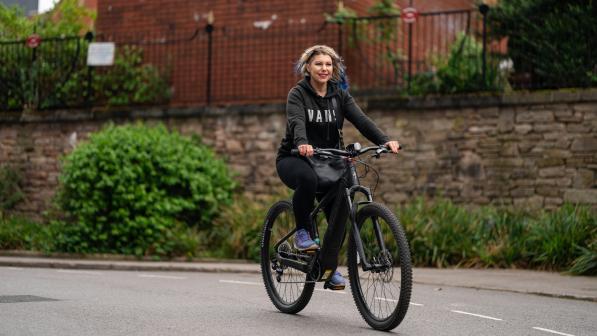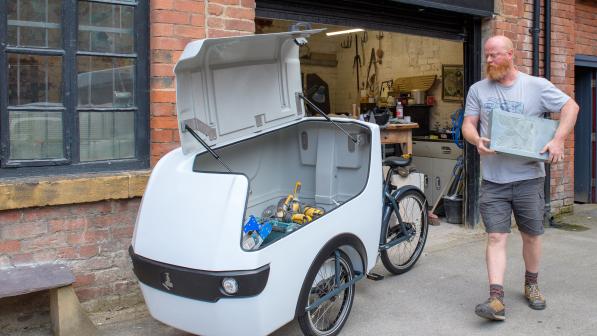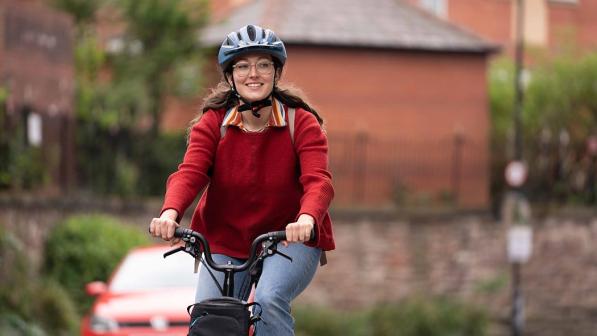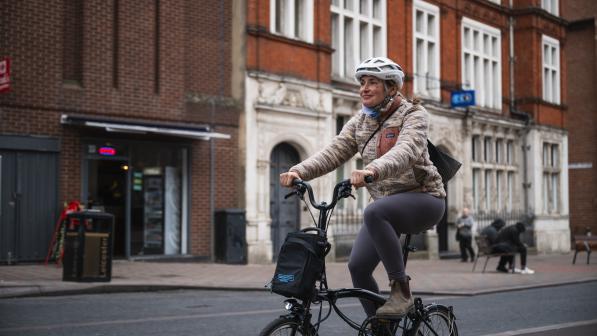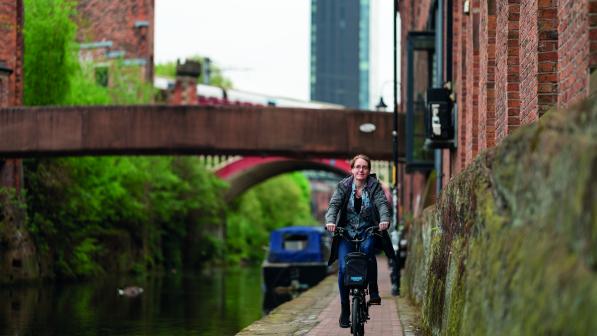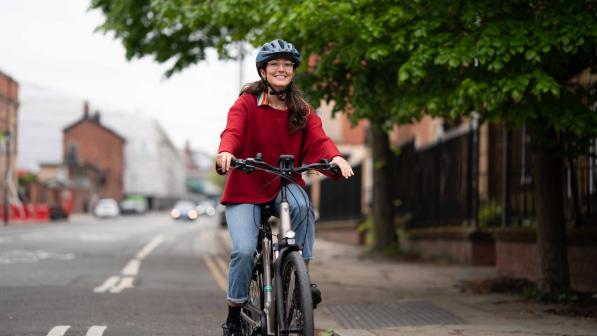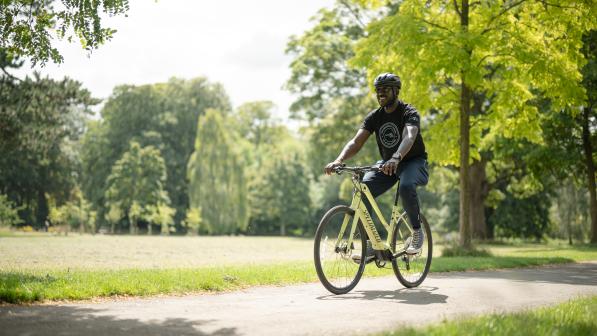Why riding an e-bike or e-cycle is good for you

‘E-cycles are cheating’. How many times have you heard that? It’s a common accusation among conventional cyclists and even people who don’t ride. The implication is that because the cycle is battery powered, it takes less effort to ride and so it’s not really exercise. But is this true?
In a word, no. And there’s a lot of research backing this up. Let’s dispel the myth that there’s no effort required in e-cycling.
What is an e-cycle?
E-cycles are more properly known as ‘pedelecs’ (from pedal electric cycle) or electronically assisted cycles. The key word here is ‘assisted’. The rider is still pedalling, but their effort is aided by a small, battery-powered motor. It provides a boost to your pedalling – it doesn’t replace it.
This motor cuts out when the rider stops pedalling and when the cycle reaches 15.5mph, at which point you’re cycling under your own steam. The rider can also choose the level of assistance, from none to a maximum set by the manufacturer. Keep in mind, too, that e-cycles are heavier than conventional ones, making them harder to push along.
E-cycling can contribute to meeting physical activity recommendations and increasing physical fitness
Jessica E Bourne, University of Bristol
This isn’t to say that the effort is the same as using a non-powered bike, but it’s not as big a gap as traditional cyclists might like to believe. In fact, one study comparing e-mountain bikes to standard mountain bikes found that riders’ average heart rate during eMTB use was 94% that of riders during conventional mountain bike use.
All the participants in the study were experienced mountain bikers, and the researchers concluded: “eMTB use appears to be an excellent form of aerobic or cardiovascular exercise, even for experienced mountain bikers who regularly engage in this fitness activity.”
Bikes with benefits
One of the best things about cycling is that you can combine getting to work, doing the shopping or having some fun with getting fit. And that’s just as true of e-cycling.
One systematic review of research into physical activity and e-cycling found that e-cycling provides physical activity of least moderate intensity – the NHS recommends that adult should get at least 150 minutes’ moderate intensity activity per week.
This was lower than the intensity elicited during conventional cycling, but higher than that of walking. Additionally, e-cycling can improve cardiovascular health in more inactive people.
The study concluded that: “E-cycling can contribute to meeting physical activity recommendations and increasing physical fitness.” And far from ‘cheating’, “e-bikes offer a potential alternative to conventional cycling”.
It’s true that e-cycling doesn’t require quite as much effort as non-assisted cycling on comparable journeys, but that isn’t the full story.
One massive study of more than 10,000 people comparing e-cyclists, cyclists and non-cyclists across seven European cities found that overall cyclists and e-cyclists amassed roughly the same amount of physical activity.
This is because the electric assistance allowed for longer and more journeys. Interestingly, it wasn’t just e-cycle journeys that increased. The e-cyclists reported more e-cycling journeys and cycling journeys than the cyclists. Unsurprisingly, the e-cyclist group recorded significantly more activity than the non-cyclist group (as did the cyclist group).
The motor provides assistance, but as with conventional cycling, the rider decides how hard they want to push, and they can reduce the amount of assistance. You can use the motor to make riding in general easier, but you can also choose to put in extra effort yourself.
The research also busted the myth that e-cycles only replace conventional cycles. In fact, it was evenly split across trips by car, public transport and bikes.

That small motor allows riders to go further and faster. This is especially useful for anyone who wants to swap short journeys – shopping, for example, or your commute – from the car or public transport to a cycle, regardless of whether or not they’re already cyclists.
Derrick Udusegbe is a beneficiary of free one-month e-cycle loan through Cycling UK’s Making cycling e-asier scheme (see sidebar).
He says of his Specialized Vado SL 4.0 loan: “Manchester is very hilly, so I used to dread cycling uphill, but the e-cycle was light and easy to use, with a large range of gears, which allowed me to reach the top without feeling very out of breath. This made journeys more enjoyable, and I like the fact that I still had to use my legs to power the bike. I’m also pleased to have lost a lot of weight.”
Mood boost
Cycling is well known for improving mental health. This is in part because it’s excellent cardiovascular exercise. As the research shows, e-cycles are almost as good at this as conventional bikes.
You’re also getting all the benefits of being outside and, especially with e-mountain biking, in nature, which has been shown to have a great mood-improving effect. This means that e-cycles deliver all the same wellbeing benefits as non-assisted cycles.
But e-cycles also have their own particular benefits. For one thing, lack of energy is a symptom of many mental health conditions – especially depression. The extra assistance provided by an e-cycle can empower people who might otherwise feel too fatigued to exercise to get active.
E-cycling is very good at reducing stress, more so than conventional cycling. This is likely to be because of that slightly reduced effort. Cycling feels easier and more enjoyable, meaning the rider feels less stressed and happier.
This is true even though that effort is only marginally less. Going back to that eMTB study, researchers found that even though the eMTB riders reached at least moderate levels of exercise intensity, with most reaching vigorous levels, their perceived exertion while riding the eMTB was low.
Riding an e-cycle is also an excellent way of promoting a sense of independence. That perceived sense of less effort makes it more accessible to anyone who might feel daunted by the idea of conventional cycling.
Anecdotally, this certainly seems true and it can only be a matter of time before the phrase ‘e-bike grin’ enters the cycling lexicon. Talk to anyone who’s ridden an e-cycle and they’ll all mention the pure joy of it.
What amazing pieces of kit! So much fun!! Can’t stop smiling!
Putu Winchester, Making cycling e-asier recipient, on Twitter
Putu Winchester, another Making cycling easier beneficiary tweeted: “Just cycled from Evans on Queen’s Road to Sharrowvale on my e-bike hire from @WeAreCyclingUK. What amazing pieces of kit! So much fun!! Can’t stop smiling!”
Derrick Udusegbe adds: “Everyone says I’m addicted to my e-cycle now. When I ride I feel much calmer, much more relaxed and I think that when you sit in a car life passes you by, whereas when I cycle I’m more engaged. The kids get so excited when we use the e-bike to go anywhere, they love watching the world go by as we pedal.”
When e-bike is best
So we’ve seen that e-cycles are as good as non-assisted cycles, but there are a whole host of situations where e-cycles offer something that conventional cycles can’t.
The perceived lower level of effort makes e-cycles particularly good for older riders or people new or returning to exercise. The fear that they won’t be able to ride far or will find themselves unable to continue far from home prevents many people from taking up cycling. E-cycles overcome this, providing riders with a bit of extra help and increasing their confidence.
This is backed up by research. A new study, published in PLOS One and conducted at the University of Reading and Oxford Brookes University, found that cyclists between the ages of 50-83 experienced better cognitive and mental health benefits from e-cycling compared to conventional cycling. This surprised even the researchers.
Prof Carien Van Reekum, a professor of psychology at the University of Reading, said: “Among the older adults involved in this project, e-bikes have a number of very positive benefits and in some cases even more so than standard cycles. The findings were not fully what we expected as we thought that the biggest benefit would be seen in the pedal bike group, with cognitive and wellbeing benefits linked to cardiovascular exertion.
“We had thought that those who used traditional, pedal-only powered bikes would have the greatest brain and mental health boost, as they would be giving their cardiovascular systems the biggest workout.
“Instead, people who used e-bikes told us that they felt more confident in completing the requested activity of three 30-minute rides a week for eight weeks, compared to pedal bikers. The fact that the group was able to get outside on a bike, even without much physical exertion, is likely to make people feel mentally better.
“If having a bit of extra help from an electric motor encourages more people to cycle, the positive effects can be shared across a wider age range and with people who are less confident on a bike.”
Similarly, researchers in Australia found that commuting by e-cycle could improve mental and physical health, happiness and overall sense of wellbeing among overweight, inactive adults.
This also applies to anyone with physical conditions such as asthma, diabetes or arthritis, as well as those recovering from injury or undergoing physiotherapy. Researchers at the University of Bristol looked at how patients with type 2 diabetes could use e-cycling to help them manage their condition.
They were particularly interested in active travel, as active commuting is known to increase physical activity in adults. They recognised that common barriers to cycle-commuting include hilly terrain, poor physical fitness, lack of time and the distance to work.
Participants reported an improvement in their blood glucose levels and weight loss, raised levels of motivation for activity and more opportunity to interact with friends and family, all of which they attributed to e-cycling.
One even commented: “My average blood sugar level was back down below the trigger point for the diabetes. The weight is coming off. I’ve lost another stone in the process of doing this. Bearing in mind that I haven’t changed anything else.”
The claim that e-cycles are cheating isn’t just inaccurate. It’s gatekeeping. E-cycles allow even the fittest, ablest and most confident cyclists to go further and faster, making it more practical for them to cycle to work or to the shops.
But more importantly, it opens up cycling – with all its mental and physical health benefits, and its environmental credentials – to people who might otherwise find cycling intimidating, for whatever reason. And that’s something to be encouraged.
